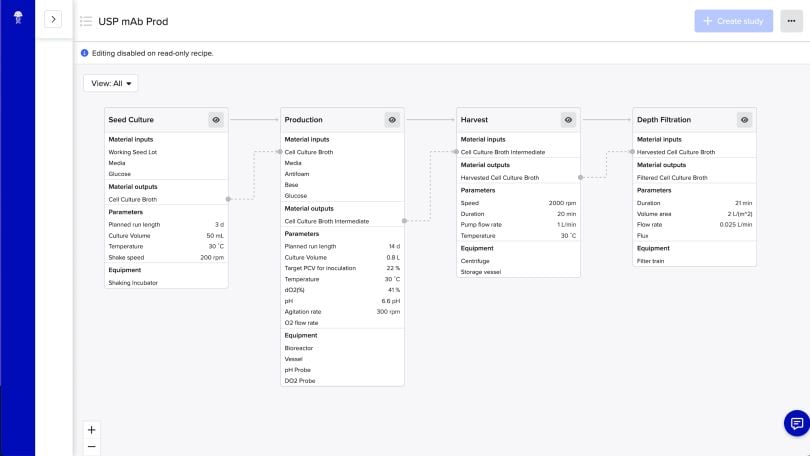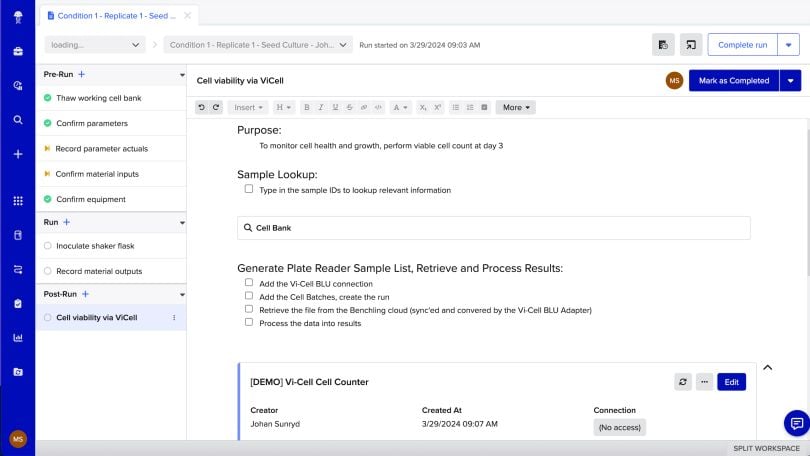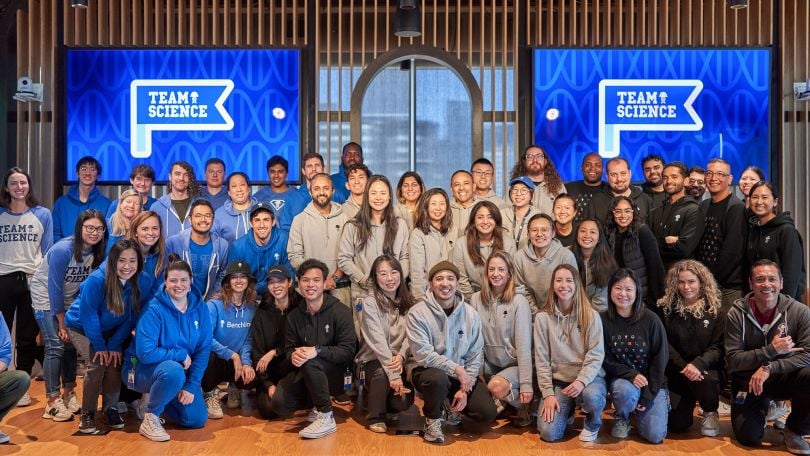Scientific research moves slowly, but creating the tech that powers that research is anything but slow.
When Jennifer Weng, a product designer for Benchling, looks back on the time that she was first brought into a new product launch called Bioprocess, the word that comes to her mind is “chaotic.”
“Being thrown in the chaos, however, helped me learn how to navigate problems effectively,” said Weng. “The challenges I faced gave me opportunities to learn how to align stakeholders through developing design artifacts, to design effectively under tight deadlines and limited scope, and to maintain high user experience standards even when dealing with hard decisions.”
When Weng was running at speed with the engineering team, she found that she was able to hear the customer voice more clearly.
“The fast-paced development process was daunting, but it pushed me to not lose sight of the ideal user experience by collaborating closely with engineering to realize it incrementally,” she noted.
WHAT DOES BENCHLING DO?
Benchling develops modern software to accelerate modern science. Think of Benchling as your central source of truth for biotech R&D. Its R&D Cloud helps scientists centralize data, improve collaboration and access insights, ultimately accelerating time to milestone and market.
Weng was able to hone her user research skills by communicating regularly and systematically with internal subject matter experts and customers. “From planning research, moderating sessions and synthesizing feedback to integrating the feedback into implementation — I learned how to maximize research value and leverage data to push for better user experience.”
To say that the experience is radically different for Benchling users with Bioprocess, the newly launched end-to-end process development platform, is an understatement.
“We built Bioprocess to give scientists a holistic, end-to-end solution that accelerates process development,” said Jorge Brake, who is also a product designer on the team. “Process development is how scientists scale up a process — in the context of our customers, this process is how they produce new medicines, drugs and treatments. This has the potential of accelerating how quickly these new medicines can reach everyday people.”
Currently, scientists must dedicate a significant portion of their time towards creating, gathering, and managing siloed and disconnected data.
“That is valuable time that could be spent doing actual scientific work,” said Weng.
Weng recalled a conversation she had with a scientist during her user research excavation. The scientist told her about how finding a single piece of information can mean sifting through hundreds of electronic lab notebooks.
“We saw a need to fix that by bringing all parts of process development into one solution,” Weng explained. “What we’ve ended up with is an end-to-end solution that offers a centralized platform for designing experiments, executing experiments, capturing execution data, analyzing results and iterating on experiments.”

How Bioprocess Works
The benefits of Bioprocess are easy to see and incredibly impactful in action. Say a scientist is working on the research and development of a new diabetes drug. They plan their research methodology, plan the experiments and begin the data collection process while those experiments are running.
A scientist who isn’t using Benchling would spend a large portion of their time recording experiment data in various spreadsheets, then collecting and organizing experimental data from various sources. The problem with this is it can easily lead to muddied — or, at the very least, hard to track — data. Having multiple data sources and data management protocols amongst teammates can significantly slow down the research and development process by preventing teams from analyzing the data effectively and deriving actionable insights, and it can cause potential errors. When a scientist is working on a pharmaceutical drug, that time can mean the difference between life and death for some.
In contrast, if that same scientist had access to Benchling’s Bioprocess, they would be able to seamlessly collect, organize and analyze data from their experiments all within the platform. The result would mean reducing errors and enhanced data integrity. They would also be able to share that data securely with colleagues and all have access to the same insights.
“Scientists will no longer need to jump between applications or spend hours trying to find the information they need to iterate on their process,” said Weng.
The time that Bioprocess can save scientists is significant. Benchling’s research found that individuals in the biopharmaceutical industry spend 23 percent of the time collecting and structuring data for analysis. Bioprocess streamlines that process and gives scientists more time to focus on analysis and decision-making.

How Bioprocess was Built
Bringing Bioprocess to life required an intimate understanding of what scientists and other customers needed. However, reaching that level of understanding had its challenges.
“Initially we went through many rounds of design iterations without much input from customers or subject matter experts, which left us not feeling very confident in what we had designed,” said Brake. “We felt like we were running blindly for a while because it was difficult to get a hold of customers to do research.”
Brake and Weng were eventually able to plan and execute research with internal subject matter experts — many of whom worked as scientists before working at Benchling — and were able to leverage their feedback to validate their product designs.
“There was a point in the project where the Bioprocess product was getting increasingly complex,” Brake noted. “We were adding new features and capabilities that were pushing the product’s information architecture to its limits. What we had initially designed wasn’t scaling well, and we were concerned customers were going to have a hard time navigating the end-to-end solution.”
Then, the product design team came up with a new information architecture for the product. “We believed this would not only scale better, but also match our users’ mental models more closely than before,” he added.
Brake was able to test this new information architecture with internal subject matter experts and found it to perform much better than the earlier iteration. “This gave us the confidence and data we needed to push for this new information architecture with stakeholders and ensure it would get built.”

Designed for Collaboration
“Sometimes, it feels like I’m collaborating with every team,” said Weng.
Since Bioprocess is powered by multiple platform capabilities, she explained that working with designers, product managers and engineers from different teams in Benchling was both challenging and the factor that makes the product so valuable.
“To me, successful cross-functional collaboration hinges on well-organized meetings and clear documentation,” noted Weng. “Ensuring the right representatives are present and that everyone is in alignment on decisions and actionables by the end of each meeting helps to keep folks on the same page and maintain momentum. We’re getting closer to achieving this and are continually refining our processes.”
Weng summed it up by noting that the working model that the product designers were used to — where one scrum team was responsible for one experience — shifted to multiple scrum teams supporting one experience.
“To tackle this, we evolved — and are still evolving — our process and collaboration model,” said Weng. “We spent time understanding the needs of each function, shifted to a cross-team collaboration ownership model and improved documentation to bring clarity across teams.”
Weng explained that the design team faced challenges around design ownership. “It pushed us to improve our documentation,” she shared. “Initially, undefined ownership made it slow and hard to make the appropriate design decisions.”
Weng was able to help develop a table to track ownership and status, adopting a “capability- based model,” as she calls it.
“With this model, one designer owns an experience that could span multiple apps, with other designers designated as collaborators,” she said. “We’re able to identify streams of collaboration and designate people to drive those collaborations.”
“We’re able to identify streams of collaboration and designate people to drive those collaborations.”
Brake agreed that the project held specific challenges, especially when it came to working across so many departments.
“Collaborating cross-functionally and across teams to build a new, end-to-end product experience under a tight deadline was very challenging,” he said. “There were a lot of moving pieces and we had to make many trade-offs along the way to make sure we delivered on time.”
Brake worked closely with designers in other teams to run concept and usability tests with internal subject matter experts. Part of his role also included work with product managers, software engineers in other scrum teams, implementation managers and customer success managers regularly.
However, he noted that he learned the most during this process from his fellow designers. “They helped me stay organized in terms of tracking bugs, usability improvements and feedback in order to help prioritize and plan future work for this new product,” he shared.
“Designers are very collaborative, both by choice but also by the nature of how Benchling is evolving as a product,” concluded Brake. “We’re building more solutions that cut across multiple product areas, rather than building siloed experiences that are specific to one product area.”







